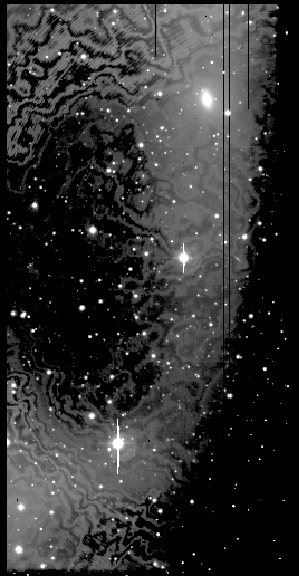HOW-TO Correct fringes in science images¶
Thinned CCD detectors may display an effect called “fringes” when filters towards the red end of the visible spectrum are used (e.g. Johnson/Cousins R, I and Z filters). Fringes are a thinned-film interference effect invoked by the presence of distinct emission lines produced in the atmosphere. The structure of the fringes in a CCD is determined by variations in the thickness of the CCD’s silicon layer. In addition, the amplitude of fringes depends on atmospheric conditions and exposure time. Fringes are an additive effect; correction is achieved by creating a FringeFrame calibration image, which is scaled and subtracted from science images after the bias and flat-field are applied.
A science image in the I-band, displaying fringes (left) and a
corresponding FringeFrame calibration image (right).
OmegaCAM i-band observations can contain large-scale background fluctuations even after flat-fielding which can cause problems with defringing. Background subtracted images are therefore used in the creation of the fringe frames, and the scale factor is derived from background subtracted science frames.
Creating a FringeFrame¶
FringeFrame s are created from a subset of all science images taken
during a night, by calculating a median image of the cube of the
selected science images. It is best to avoid exposures with nearly
identical pointings or extended sources to prevent artifacts due to
stars or galaxies in the median image.
In the following example all science images for a particular night, filter and CCD are selected.
awe> task = FringeTask(instrument='WFI', date='1999-06-16', filter='#845', chip='ccd54')
awe> task.execute()
Using the DPU for all CCDs:
awe> dpu.run('FringeFlat', i='WFI', d='1999-06-16', f='#845')
Alternatively, a subset of raw science images can be specified manually, by giving their filenames:
awe> task = FringeTask(raw=['science1.fits', 'science2.fits', 'science3.fits'])
awe> task.execute()
Using the DPU:
awe> dpu.run('FringeFlat', raw=['science1.fits', 'science2.fits', 'science3.fits'])
De-fringing science images¶
If a FringeFrame is available for the appropriate CCD and filter, it will automatically be used when science images are reduced (see HOW-TO Create a ReducedScienceFrame)


